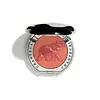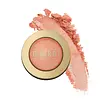What's inside
What's inside
 Key Ingredients
Key Ingredients

 Concerns
Concerns

 Ingredients Side-by-side
Ingredients Side-by-side

Talc
AbrasiveMica
Cosmetic ColorantZea Mays Starch
AbsorbentZinc Stearate
Cosmetic ColorantDimethicone
EmollientCetearyl Ethylhexanoate
EmollientOctyldodecyl Stearoyl Stearate
EmollientPentaerythrityl Tetraisostearate
EmollientPtfe
Polyethylene
AbrasiveSilica
AbrasiveChlorphenesin
AntimicrobialPotassium Sorbate
PreservativeDimethiconol
EmollientNylon-12
Tetrasodium EDTA
Lauroyl Lysine
Skin ConditioningAcrylates/Octylacrylamide Copolymer
Isostearyl Alcohol
EmollientTin Oxide
AbrasiveCI 77891
Cosmetic ColorantCI 77491
Cosmetic ColorantCI 15850
Cosmetic ColorantCI 19140
Cosmetic ColorantTalc, Mica, Zea Mays Starch, Zinc Stearate, Dimethicone, Cetearyl Ethylhexanoate, Octyldodecyl Stearoyl Stearate, Pentaerythrityl Tetraisostearate, Ptfe, Polyethylene, Silica, Chlorphenesin, Potassium Sorbate, Dimethiconol, Nylon-12, Tetrasodium EDTA, Lauroyl Lysine, Acrylates/Octylacrylamide Copolymer, Isostearyl Alcohol, Tin Oxide, CI 77891, CI 77491, CI 15850, CI 19140
Talc
AbrasiveMica
Cosmetic ColorantGlyceryl Ethylhexanoate/Stearate/Adipate
EmollientDimethicone
EmollientOctyldodecyl Stearoyl Stearate
EmollientIsopropyl Myristate
EmollientPolyacrylamide
C13-14 Isoparaffin
EmollientLaureth-7
EmulsifyingSorbitan Stearate
EmulsifyingZea Mays Starch
AbsorbentLauroyl Lysine
Skin ConditioningMagnesium Aluminum Silicate
AbsorbentCetearyl Ethylhexanoate
EmollientSodium Dehydroacetate
PreservativeNylon-12
Imidazolidinyl Urea
PreservativeMethylparaben
PreservativeSilica
AbrasiveEthylparaben
PreservativePropylparaben
PreservativeButylparaben
MaskingCI 77891
Cosmetic ColorantCI 77491
Cosmetic ColorantIron Oxides
CI 19140
Cosmetic ColorantCI 15850
Cosmetic ColorantCI 15985
Cosmetic ColorantCI 75470
Cosmetic ColorantCI 77007
Cosmetic ColorantTalc, Mica, Glyceryl Ethylhexanoate/Stearate/Adipate, Dimethicone, Octyldodecyl Stearoyl Stearate, Isopropyl Myristate, Polyacrylamide, C13-14 Isoparaffin, Laureth-7, Sorbitan Stearate, Zea Mays Starch, Lauroyl Lysine, Magnesium Aluminum Silicate, Cetearyl Ethylhexanoate, Sodium Dehydroacetate, Nylon-12, Imidazolidinyl Urea, Methylparaben, Silica, Ethylparaben, Propylparaben, Butylparaben, CI 77891, CI 77491, Iron Oxides, CI 19140, CI 15850, CI 15985, CI 75470, CI 77007
Ingredients Explained
These ingredients are found in both products.
Ingredients higher up in an ingredient list are typically present in a larger amount.
Cetearyl Ethylhexanoate is derived from cetearyl alcohol and sorbic acid.
It is an emollient and helps hydrate the skin. Emollients form a barrier on the skin to prevent water from escaping.
Ci 15850 is the pigment color red. It is an azo dye and created synthetically.
Azo dyes need to be thoroughly purified before use. This allows them to be more stable and longer-lasting.
This ingredient is common in foundations, lipsticks, and blushes. This color is described as brown/orangey red.
It has many secondary names such as Red 6 and Red 7. According to a manufacturer, Red 6 usually contains aluminum.
Learn more about CI 15850CI 19140 is also known as Tartrazine. Tartrazine is a synthetic dye used in cosmetics, foods, and medicine to add a yellow color.
Tartrazine is created from petroleum and is water-soluble.
Some people may experience allergies from this dye, especially asthmatics and those with an aspirin intolerance.
Learn more about CI 19140Ci 77491 is also hydrated iron III oxide. It's sole purpose is to give a red/pink hue to products.
Iron III oxides are classified as inorganic chemicals for coloring.
Synthetically created Ci 77491 is considered safer than those naturally found. This is because the synthetically created version may contain less impurities. Iron oxides are generally non-toxic and non-allergenic.
Learn more about CI 77491Ci 77891 is a white pigment from Titanium dioxide. It is naturally found in minerals such as rutile and ilmenite.
It's main function is to add a white color to cosmetics. It can also be mixed with other colors to create different shades.
Ci 77891 is commonly found in sunscreens due to its ability to block UV rays.
Learn more about CI 77891Dimethicone is a type of synthetic silicone created from natural materials such as quartz.
What it does:
Dimethicone comes in different viscosities:
Depending on the viscosity, dimethicone has different properties.
Ingredients lists don't always show which type is used, so we recommend reaching out to the brand if you have questions about the viscosity.
This ingredient is unlikely to cause irritation because it does not get absorbed into skin. However, people with silicone allergies should be careful about using this ingredient.
Note: Dimethicone may contribute to pilling. This is because it is not oil or water soluble, so pilling may occur when layered with products. When mixed with heavy oils in a formula, the outcome is also quite greasy.
Learn more about DimethiconeThis ingredient comes from a fatty acid (lauric acid) and amino acid (lysine). It is used to add a silky feel to cosmetics.
According to a manufacturer, its fatty acid base leaves a silky feeling on the skin. It also has emollient properties because of this. Emollients help soften skin by preventing water from evaporating.
Lauroyl lysine is barely soluble in water.
Learn more about Lauroyl LysineMica is a naturally occurring mineral used to add shimmer and color in cosmetics. It can also help improve the texture of a product or give it an opaque, white/silver color.
Serecite is the name for very fine but ragged grains of mica.
This ingredient is often coated with metal oxides like titanium dioxide. Trace amounts of heavy metals may be found in mica, but these metals are not harmful in our personal products.
Mica has been used since prehistoric times throughout the world. Ancient Egyptian, Indian, Greek, Roman, Aztec, and Chinese civilizations have used mica.
Learn more about MicaNylon-12 is a polymer. It is derived from 12-aminododecanoic acid, an omega-amino fatty acid
According to a manufacturer, it is a talc substitute. Like talc, nylon-12 gives products a satin feel. The manufacturer also claims this ingredients does not block pores and has moderate oil absorption.
This ingredient may not be reef-safe.
Learn more about Nylon-12Octyldodecyl Stearoyl Stearate is created from stearic acid.
It is an emollient and thickens the lipid (oil) portion of a product. Due to its emollient properties, it may not be fungal-acne safe.
Silica, also known as silicon dioxide, is a naturally occurring mineral. It is used as a fine, spherical, and porous powder in cosmetics.
Though it has exfoliant properties, the function of silica varies depending on the product.
The unique structure of silica enhances the spreadability and adds smoothness, making it a great texture enhancer.
It is also used as an active carrier, emulsifier, and mattifier due to its ability to absorb excess oil.
In some products, tiny microneedles called spicules are made from silica or hydrolyzed sponge. When you rub them in, they lightly polish away dead skin layers and enhance the penetration of active ingredients.
Learn more about SilicaTalc is a clay mineral. It helps absorb moisture and improve the texture of products. Like other types of clay, Talc can have a slight exfoliating effect on skin. Talc can be added to increase the volume of products.
Some Baby powders are made by combining talc with corn starch. The word "talc" comes from Latin and originates from Arabic. Talc is a mineral commonly found throughout the world.
If you have any concerns about using talc, we recommend checking out the FDA's official page.
Learn more about TalcZea Mays Starch is starch made from corn. You might know this as cornstarch . It is used to thicken a product. It can replace talc as an absorbent.
The pH of cornstarch is 5.92.
Cornstarch is a common food ingredient used to thicken soups or to make corn syrup.
Learn more about Zea Mays Starch